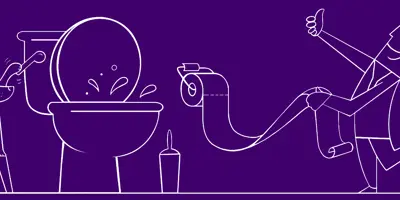1 person found this helpful

It’s not the sort of question you’re usually asked, but do you know how to poo properly? Despite being one of your most regular routines, you might be surprised to find you can get even better at it, and there is a best way to poo! That’s why we've put together this handy guide packed full of tips for happier, more healthy bowel movement. Read on for our 4 tips for how to poo properly including:
- How do you use the toilet.
- The best diet ideas to avoid not pooing properly.
- The correct way to poop.
- Exercises to help you poop.
How do you use the toilet: Tips for healthy bowel movement
Constipation or an unhealthy poo is never pleasant. Not only can it make you super uncomfortable, but it can also lead to more serious complications if left untreated.1 If advised by a medical professional, you may be able to try laxatives, but if you’ve found yourself a little backed up and want a more natural solution, try these tips to relieve yourself of an unhealthy poo:
- Drink fruit juice. Whether it’s a glass of orange juice or a teaspoon of lemon juice diluted in a cup of warm water, certain fruits are full of vitamin C, which can help to pull water content into the gut. This can soften your poop and potentially make it easier to pass.2
- Try prunes. You’ve probably heard of this one before, as these dried fruits are one of the most popular, natural remedies for constipation relief. Prunes contain sorbitol which works as a natural laxative.3
- Have a bit of aloe vera. This one may shock you, but trust us, it works. As well as being an antioxidant with antibacterial properties, it’s actually a surprisingly effective natural laxative too.4
Don’t forget: If you are facing long-term constipation, be sure to chat to your pharmacist or GP. They can offer advice and reassurance to help you get your bowel movements back on track.
Diet ideas to avoid not pooing properly
No doubt you already know that what you eat is a big factor in maintaining proper bowel movement, but what does this actually mean for your diet? Here are a few simple changes you can make to your diet before we show you how to poo properly:
- Maintain a balanced diet with plenty of fibre.5 The best sources of fibre include nuts (such as walnuts, cashews, and peanuts), beans, lentils, fruit (such as avocado and apple), whole grains (such as whole-wheat bread and pasta), and brown rice.
- Drink plenty of water to stay hydrated. Healthy bowel movements need water, so keep yourself hydrated throughout the day and try cutting back on caffeine if you suffer from regular constipation.5
- Cut back on fatty foods. Chips, burgers, fast food, and other fatty foods can lead to uncomfortable stomach pains and make it harder to maintain good digestion and proper bowel movement.6
- Don’t be afraid to avoid certain drinks too. Coffee can cause constipation if drank in large quantities because it can lead to dehydration.7 Similarly, carbonated drinks can also have adverse effects due to leaving you feeling bloated and giving you gas.8
As with everything, moderation is key. Too much or too little of anything, as well as digestive stimulants like coffee, can lead to constipation, bloating or diarrhoea.
If you have frequent poo troubles or experience serious discomfort when going to the toilet, then make sure you speak to your GP for poop help. They can advise on the best way to poo and train bowel movements and what you can do to relieve your symptoms.
The correct way to poop
Over the last few years, there has been serious (and not-so-serious) discussion over whether or not we’re sitting properly during our bowel movements. Like many creatures, we poo in a squatted position – and whilst this is the best poop position9 during bowel movement, there are a few differences that affect our ability to achieve a healthier bowel movement:
- The modern toilet design has us sit up fairly straight with a 90° angle between spine and thighs.
- Because we typically do the business in the bathroom, we have to strain more when we poo.
- Believe it or not, there are better ways to go...
The best poop position is actually more of a 35° angle, as if you’re squatting down on the floor. As it’s unlikely that our bathrooms will be designed for this anytime soon, here are a few steps we offer as the simplest advice for answering how to use the toilet:
- Lean forward while sitting on the toilet.
- Angle your chest towards your knees.
- If possible, place your feet on a small footstall.9 This will angle your body further into a squatting pose.
Exercises to help you poop
From reducing your risk of illness including heart disease and diabetes10 to helping your mental health11, it’s no secret that regular exercise improves your health in almost every way – and bowel health is no exception. It might be the last thing you feel like doing when you’re not feeling yourself, but here are a few ideas that will help you when it comes to going to the toilet properly:
- A few star-jumps.
- A quick jog.
- Gentle stretches.
If getting hot and sweaty isn’t your idea of fun, try giving your navel a quick massage instead. Lie down on your front with a rolled-up towel underneath your lower stomach and gently roll yourself forwards and back, or just knead the area with your fingers, applying a gentle pressure.
There you have it. With these four simple tips and tricks of poop help we have shown you everything you never knew you needed to know about how to use the toilet. With these tricks under your belt, you’ll be well on your way to achieving healthy bowel movements.
Sources
3 Review of efficacy and safety of laxatives use in geriatrics, National Library of Medicine
4 Evaluation of the Nutritional and Metabolic Effects of Aloe vera, National Library of Medicine
6 Good foods to help your digestion, NHS
8 Carbonated beverages and gastrointestinal system, National Library of Medicine
10 Exercise health benefits, NHS
11 Exercise and Mental Health: Many reasons to move, National Library of Medicine
Related articles
A guide to healthy urine: colour chart and meaning of your pee colour
Do you know what healthy urine colour looks like? Or the signs of dehydration or infection? Learn the urine colour chart and meaning to check your health.

What is a normal stool colour? A guide with poo chart
What is a normal stool colour? Discover everything you didn’t know you needed to know about poo using our stool chart and handy guide.

Why do men pee while standing?
Being able to urinate standing can come with unexpected challenges. Wondering how to pee properly? Men: here’s some advice on urinating; sitting or standing.

10 feminine hygiene tips you may not know
Need feminine hygiene advice for yourself or your child? This is a feminine-care resource for women of all ages. Click here to find out more.

Dry eyes: causes and symptoms
Discover what can cause dry eyes and dry eye symptoms. Use our easy-to-follow guide to fight back, and help to ease and avoid dry irritated eyes in the future.

9 toilet hygiene rules
How can you ensure your family follows good hygiene in the loo? Check out our 10 toilet hygiene rules, and download our handy toilet rules sign, here.



